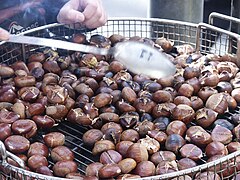Cookbook:Chestnut
| Chestnut | |
|---|---|
 | |
| Category | Nuts and seeds |
Cookbook | Recipes | Ingredients | Nuts and Seeds
Chestnuts (also called chinkapins or chinquapins) are edible tree nuts.
Characteristics[edit | edit source]
Growing in large spiky pods, the nuts themselves are surrounded by a smooth brown shell.[1] The nut meat is much starchier than other nuts, which tend to be high in oils.[2][3] Once cooked, this starchiness gives the flesh a texture similar to that of a baked potato, with a delicate, sweet, nutty flavor.[4][5]
Chestnuts are available fresh, dried, frozen, canned, ground to a flour, or puréed.[1][6] Candied whole chestnuts are sold under the French name marrons glacés or the Turkish name kestane şekeri.[4]
Foragers searching for wild chestnuts should be careful to avoid confusion with the very similar looking but poisonous "horse chestnut" or "buckeye".
Seasonality[edit | edit source]
Fresh chestnuts are highly seasonal and only available during autumn and early winter of the northern hemisphere.[4] During the remainder of the year, they must be purchased in one of their preserved forms.
Selection and storage[edit | edit source]
If choosing whole, fresh, in-shell chestnuts, select firm, glossy nuts with no blemishes.[2] These should be stored in a sealed container in the fridge to delay drying and spoilage. Canned or jarred nuts will keep for a very long time at room temperature but must be refrigerated after opening.[4] Dried chestnuts and chestnut flour should be kept in an airtight container away from light, heat, and moisture.[5]
Preparation[edit | edit source]
Chestnuts must be cooked before eating,[6] and all cooking methods require them to be scored beforehand in order to prevent explosion and facilitate peeling.[5] The best way to do this is to set the nut on a stable surface before carefully using the tip of a paring knife to cut an X shape into it.[2][5] If roasting or otherwise dry-cooking them, soaking the scored nuts in water for several hours helps steam them in the skins and make them easier to peel. Dried chestnuts must be soaked or steamed to soften them.[3]
Use[edit | edit source]
Chestnuts are used in a variety of recipes, from sweet to savory. In savory preparations, the nuts may be used to stuff vegetables, poultry, and other edibles.[3] Chestnut flour may be used to prepare breads, cakes, pancakes, pastas, and soups; and, it is the original ingredient for polenta.[3] Fermentation of the juice will make a beer. Chestnut purée is used in a variety of dessert preparations, such as cakes, puddings, and confections.[1][3] One traditional French dessert called mont blanc involves elaborately piped chestnut paste served with cream.[7]
If preparing fresh chestnuts yourself, roast them for 15 minutes at 350°F (180°C) or boil/steam them until the meat is tender.
Substitution[edit | edit source]
Unfortunately, chestnuts are not interchangeable with other commonly available nuts.[4]
Gallery[edit | edit source]
-
Candied chestnuts
-
Roasting chestnuts
-
Mont blanc dessert
Recipes[edit | edit source]
References[edit | edit source]
- ↑ a b c Rinsky, Glenn; Rinsky, Laura Halpin (2008-02-28). The Pastry Chef's Companion: A Comprehensive Resource Guide for the Baking and Pastry Professional. John Wiley & Sons. ISBN 978-0-470-00955-0.
- ↑ a b c Gisslen, Wayne (2015-03-12). Essentials of Professional Cooking, 2nd Edition. Wiley Global Education. ISBN 978-1-119-03072-0.
- ↑ a b c d e Davidson, Alan (2014-01-01). Jaine, Tom (ed.). The Oxford Companion to Food. Oxford University Press. doi:10.1093/acref/9780199677337.001.0001. ISBN 978-0-19-967733-7.
- ↑ a b c d e Figoni, Paula I. (2010-11-09). How Baking Works: Exploring the Fundamentals of Baking Science. John Wiley & Sons. ISBN 978-0-470-39267-6.
- ↑ a b c d "A Guide to Cooking Chestnuts Including How to Roast, Boil, and Grill". The Spruce Eats. Retrieved 2024-03-05.
- ↑ a b Labensky, Sarah; Martel, Priscilla; Damme, Eddy Van (2015-01-06). On Baking: A Textbook of Baking and Pastry Fundamentals, Updated Edition. Pearson Education. ISBN 978-0-13-388675-7.
- ↑ Goldstein, Darra (2015). The Oxford Companion to Sugar and Sweets. Oxford University Press. ISBN 978-0-19-931339-6.


